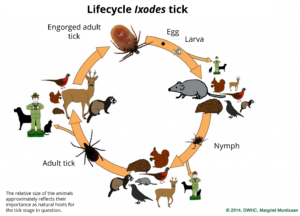

This page provides general information about this condition; reveal the text by clicking on the green headers. Press releases, results from DWHC investigations as well as other useful documents and relevant literature can be found at the bottom of the page.
Tick-borne encephalitis is a disease in humans and occasionally other animals caused by infection with the tick-borne encephalitis virus (TBEV). This virus is a member of the flaviviridae family of viruses which also includes West Nile virus and Zika virus.
In addition to humans and dogs which are both susceptible to TBEV illness, other mammals such as cattle and sheep can be infected with the TBEV, but typically do not show signs of disease. Small rodents act as reservoir hosts for the virus providing a continuous source of infection for ticks. Other species including hedgehogs,hares, roe deer and young foxes are considered as indicator species that may be infected but do not develop disease and do not infect ticks; these are indicator species, indirectly contributing to the persistence of the virus by supporting tick survival.
The few descriptions of TBEV causing disease in animals other than humans report neurological signs including tremors and seizures which may precede death.
Animals become infected with TBEV via the bite of an infected tick. Ticks are infected by biting infected animals. The population size of rodents and wild and farmed sheep, cattle and deer as well as weather conditions can influence the survival of ticks and fluctuations in these and other environmental factors influence the number of cases of TBE in humans.
In humans, infection with TBEV affects the brain and spinal cord and can cause severe acute or chronic neurological disease. Symptoms tend to be most severe in adults and the elderly and begin with an initial phase of flu-like illness shortly after infection; a proportion of infected people will experience a second phase of illness at a later stage when the virus infects the nervous system causing a range of signs including headache, visual disturbances and occasionally paralysis of limbs, possibly even coma. Due to the potential seriousness of infection in humans, TBEV is a notifiable disease according to European law.
In Europe around 3000 human TBEV patients are hospitalised each year. In addition, it is thought that a great number of people who are infected go undiagnosed.
More information on TBE in humans can be found on the website of the RIVM.
People can become infected with TBEV through the bite of an infected tick (in Western Europe the sheep tick, Ixodes ricinus) or occasionally via the consumption of unpasteurized milk or milk products from infected animals.

There are several classifications of the different types of TEBV.
One classification, based on geographic distribution recognizes three subtypes of TBEV and these circulate in different parts of Europe and Asia: In Western Europe the Western form (previously known as FSME) predominates whilst in North-Eastern Europe and Russia the Siberian subtype prevails; in Eastern Russia, Japan and China the Far-Eastern variant (previously known as Russian spring summer encephalitis virus) is found. The highest risk areas are thought to be Middle- and Eastern Europe and Southern Scandinavia.
Classification based on genetic similarity of the viruses includes Turkish sheep encephalitis virus and looping ill virus which causes ovine encephalomyelitis and can also cause meningitis in humans (this is found in the British Isles and similar viruses have been found in several other European countries including Spain) in addition to the Western (as defined above) and Eastern (comprising both Far Eastern and Siberian subtypes) forms.
A distribution map of TBEV in the Netherlands can be found on the website of the RIVM.
In some countries where the virus is endemic humans are routinely vaccinated against TBEV. In lower risk countries, as the likelihood of infection with TBEV is correlated to the likelihood of exposure to ticks, individuals should minimise the risk of tick bites for example by avoiding areas with high grass or leaf litter and by checking themselves, pets and outdoor equipment thoroughly after returning from outdoor activities.
No projects found.
No publications found.